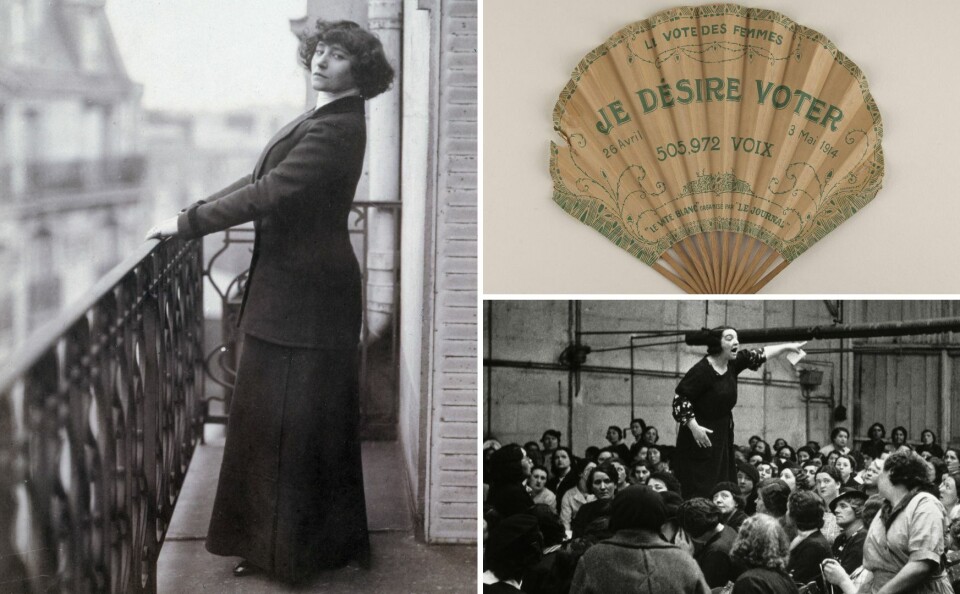-
Paris pledges action against voyeurs in public swimming pool changing rooms
It comes after several women came forward to report similar sexual assaults
-
What is known about large fire at recycling centre in Paris
Residents nearby are being urged to remain cautious over inhaling smoke
-
Photos: Hundreds of Americans protest against Trump and Musk in Paris
‘Our goal is not anti-American but anti-oligarch’, says Democrats Abroad spokesman after the ‘Hands off’ demonstration on April 5
Exhibition honours Paris suffragettes and women’s fight for equality
We look at the display celebrating brave Parisian women who fought for women’s rights in France

Women in France did not get the vote until 1944, in contrast to women in the UK who won the vote in 1918.
The struggle for female suffrage in Paris is documented in an exhibition at the Musée Carnavalet.
Parisian Women, The Fight for Emancipation (1789 - 2000), until January 29, 2023, documents the struggle for voting rights as well as the continuing struggle for equality during the 20th century.
‘Brutal police repression’ of Paris suffragettes
“We stopped at the year 2000 in order to present the history in a certain context,” says curator Juliette Tanré-Szewczyk.
“Suffragettes in Paris were not as extreme as their counterparts in London, perhaps because they were met with such brutal police repression.
“As a result, they generally avoided direct conflict with the authorities in favour of staging protests which were pre-announced to the press so journalists were there to report on the protest. But they often then abandoned it before police arrived. It was a matter of raising awareness.”
Read more: Videos and images: People in France march in Iran solidarity
Extreme actions by UK suffragettes
In the UK, suffragettes were arrested for chaining themselves to the railings of 10 Downing Street, went on hunger strike, were brutally force-fed in prisons, and in perhaps the most tragic and shocking protest of all, even died for the cause.
In 1913, to promote female suffrage, Emily Wilding Davison ran onto the racecourse during the Epsom Derby, attempting to attach a ribbon to the bridle of the king’s horse. She was trampled and died four days later of her injuries.
Women’s struggle to be heard
The idea for the exhibition was born when Juliette and fellow curators and historians Valérie Guillaume, Christine Bard, and Catherine Tambrun realised the dearth of women presented in museum exhibitions.
“So many museums don’t mention women at all. They simply don’t exist. So we wanted to illustrate their struggle to be heard, and to participate in public life.”
Well-known feminists from Olympe de Gouges (author of the Déclaration des Droits de la Femme et de la Citoyenne, born 1748, guillotined in 1793 for her activism) to Gisèle Halimi (lawyer and politician known for exposing French military sexual crimes against women in north Africa, 1927-2020) are included, as well as lesser-known feminists, revolutionaries, activists, unionists, pacifists, artists, writers and politicians.
“Many other women made significant contributions but were never individually recognised. Women who went on strike, who supported the movement, who spread new ideas.”
Read more: Remarkable life and death of France’s ‘first feminist’
Paintings, films and clothing on display
The exhibition is set out in chronological order, from the date 1789 when women won civic rights to 2000 when the law on Gender Equality was finally passed.
Between those two dates, the exhibition traces the struggle for female education, reproductive rights, the right to work, and access to artistic and cultural creation.
It includes paintings, sculptures, photographs, films, videos, posters, banners, publications, police and activists’ archives, recordings, clothing, manuscripts, books and other objects like ‘suffragettes’ soap’ and a lock of Marguerite Durand’s hair.
Marguerite Durand (1864-1936) was an actress and a journalist as well as a prominent suffragette.
Read more: La Fronde: France’s first newspaper run entirely by women
She founded her own newspaper, and ran for election to highlight even before it was legal, equality for a woman. A passionate feminist and a gifted show-woman, she was also known for having a pet lion.
The Bibliothèque Marguerite Durand in Paris, is a public library specialising in feminist literature.
It was founded in 1932 to house her collection of books, manuscripts and publications documenting the feminist struggle.
It contains more than 45,000 books dating from the 17th century and nearly 5,000 letters from women including George Sand, Sarah Bernhardt, Colette and Alexandra David-Néel.
Related articles
The female French spy who saved more than a thousand British soldiers
How reading Annie Ernaux will help you understand France
Did you know: France's president was not always elected by the people
























